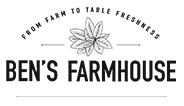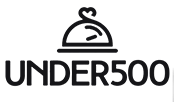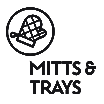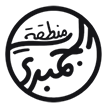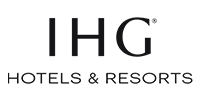Global Front-of-Pack Nutrition Labelling Systems
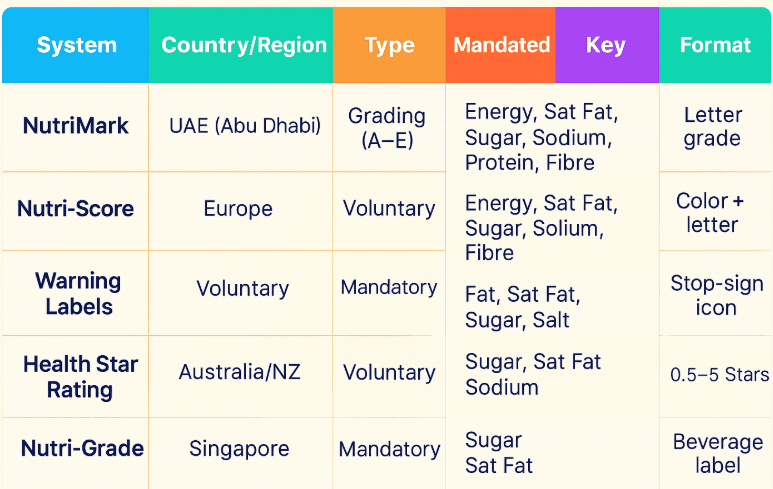
Label System Format: NutriMark
Country / Region: UAE (Abu Dhabi)
Type: Grading (A–E)
Mandated: Mandatory (2025)
Key Nutrients: Energy, Saturated Fat, Sugar, Sodium, Protein, Fibre
Format: Letter Grade
Label System Format: Nutri-Score
Country / Region: Europe
Type: Grading (A–E)
Mandated: Voluntary
Key Nutrients: Energy, Saturated Fat, Sugar, Sodium, Fibre
Format: Color + Letter
Label System Format: Traffic Light
Country / Region: UK
Type: Traffic Light
Mandated: Voluntary
Key Nutrients: Fat, Saturated Fat, Sugar, Salt
Format: Color-coded
Label System Format: Warning Labels
Country / Region: Chile, Uruguay, Canada
Type: Warning
Mandated: Mandatory
Key Nutrients: Sugar, Saturated Fat, Sodium, Calories
Format: Stop-sign icon
Label System Format: Health Star Rating
Country / Region: Australia / New Zealand
Type: Star Rating
Mandated: Voluntary
Key Nutrients: Energy, Sugar, Saturated Fat, Sodium
Format: 0.5–5 Stars
Label System Format: Nutri-Grade
Country / Region: Singapore
Type: Grading (A–D)
Mandated: Mandatory
Key Nutrients: Sugar, Saturated Fat
Format: Beverage label
Front-of-Pack Nutrition Labels (FOPNL) Explained: UAE’s NutriMark & Global Systems
What is Front-of-Pack Nutrition Labelling (FOPNL)?
In an era of information overload, making healthy food choices at the supermarket can be a challenge. Front-of-Pack Nutrition Labelling (FOPNL) is a public health tool designed to solve this. Unlike the complex, mandatory nutritional tables on the back of packages, FOP labels provide a simple, quick, and often visual summary of a product's overall nutritional quality right on the front.
These labels are a game-changer for consumers and a powerful driver for the food industry. Countries worldwide are implementing Front-of-Pack Labels (FOPL) to combat diet-related diseases like obesity, diabetes, and heart disease by empowering people to make informed decisions in seconds.
Why Did We Need Front-of-Pack Labels?
The traditional back-of-pack nutrition panel is dense with numbers and hard to interpret quickly. FOP nutrition labels solve this by:
-Simplifying Complex Data: Translating numbers into easy-to-understand colours, letters, or symbols.
-Encouraging Healthier Choices: Allowing shoppers to compare products at a glance.
-Driving Product Reformulation: Incentivizing manufacturers to improve their recipes to avoid negative labels (like red "high in sugar" warnings).
Research confirms their effectiveness. For example, studies in Chile and Uruguay showed a significant drop in the purchase of sugary and high-fat foods after warning labels were implemented.
Front-of-Pack vs. Back-of-Pack: What’s the Difference?
Feature: Purpose FOP: Quick, interpretive summary BOP: Detailed, numerical information Feature: Placement FOP: Prominent on the front of the package BOP: Typically on the back or side Feature: Format FOP: Colours, grades, stars, warnings (e.g., A–E, Red/Amber/Green) BOP: Standardized table with values per 100g/serving Feature: Audience FOP: General consumers BOP: Dietitians, health-conscious consumers, regulators
Types of Front-of-Pack Nutrition Labels: A Global Overview
While the goal is the same, the design of FOPNL systems varies. They generally fall into two primary categories: summary/grading systems that provide one overall score, and nutrient-specific systems that detail key nutrients.
Definition: A new front-of-pack nutritional labelling system that grades food and beverage products from A (highest nutritional quality) to E (lowest).
Where: Abu Dhabi, United Arab Emirates (UAE), with potential for wider GCC adoption.
Status: In discussion for becoming mandatory from 2025 in a phased rollout, starting with specific categories.
Key Categories: Oils, Dairy, Beverages, Baked Goods, and Foods targeted at children.
Nutrients Considered: Energy, Saturated Fat, Total Sugars, Sodium, Protein, Fibre, and content of Fruits, Vegetables, Legumes, and Nuts.
For businesses, achieving nutrition label compliance in the UAE is now critical. The NutriMark Abu Dhabi system is tailored to local dietary standards and Halal requirements.
Definition: A widely recognized grading system that assigns a letter from A (green) to E (red) based on the product's overall nutritional profile.
Where: First implemented in France; now adopted voluntarily in several European countries (e.g., Belgium, Germany, Spain).
Status: Voluntary.
Nutrients Considered: Balances "negative" elements (calories, sat fat, sugars, sodium) against "positive" ones (protein, fibre, fruits, vegetables, nuts).
Definition: This system uses colour codes (red, amber, green) to show the level of key nutrients per serving.
Where: Originated in the UK and adopted in various forms in other countries like Ecuador.
Status: Voluntary in the UK.
Nutrients Considered: Energy, Fat, Saturated Fat, Total Sugars, and Salt.
Effectiveness: This system is highly understood, with 87% of UK adults reporting it helps them make informed choices.
4. Warning Labels (Chile, Uruguay, Canada)
Definition: These are mandatory, black-and-white stop-sign labels that appear on products high in critical nutrients.
Where: Chile (pioneer), Uruguay, and Canada (mandatory from 2026).
Status: Mandatory.
Nutrients Considered: Typically sugars, saturated fat, sodium, and sometimes calories. They are highly effective at shifting consumer purchasing habits.
5. Health Star Rating (Australia/NZ)
Definition: A system that rates products from ½ a star to 5 stars, with more stars indicating a healthier choice.
Where: A collaborative initiative between Australia and New Zealand.
Status: Voluntary.
Nutrients Considered: Energy, Saturated Fat, Sodium, Total Sugars, and positively, Protein, Fibre, and content of Fruits, Vegetables, Nuts, and Legumes.
Definition: A mandated system focused specifically on beverages, grading them from A to D based on their sugar and saturated fat content.
Where: Singapore.
Status: Mandatory.
Nutrients Considered: Total Sugar and Saturated Fat. Its targeted approach aims to reduce sugar intake and combat diabetes.
FOPNL FAQ Section
Why are front-of-pack labels important?
They provide a quick, easy-to-understand snapshot of a food's healthfulness, helping busy consumers make healthier choices without needing to decipher complex nutritional tables.
Is NutriMark mandatory in the UAE?
In discussion.
NutriMark system is being discussed for a phased rollout starting in 2025. It will initially apply to specific food categories like beverages, oils, and children's foods.
What’s the difference between Nutri-Score and Traffic Light systems?
The Nutri-Score gives one overall grade (A–E) for the product. The Traffic Light system provides individual colour codes for multiple nutrients (e.g., fat, sugar, salt), allowing you to see a more detailed breakdown.
Do all countries use the same FOPNL system?
No. There is no single global standard. Countries choose or adapt systems based on their public health goals and dietary patterns. In fact, a 2024 study found a low level of agreement between different systems when applied to the same food, highlighting the need for nationally tailored approaches.
Disclaimer
This article is intended as an informational guide to global Front-of-Pack Nutrition Label (FOPNL) systems. The details provided, including implementation timelines and specific requirements, are subject to change. While we strive for accuracy, this information should not be used as a substitute for official legal or regulatory advice. For definitive guidance, especially regarding the NutriMark system in the UAE, we strongly recommend consulting the official authorities, such as the Abu Dhabi Agriculture and Food Safety Authority (ADAFSA).
Conclusion: The Future of Food is Clearer Labelling
Front-of-pack nutrition labelling is more than a trend; it's a fundamental shift towards transparency and public health. From the warning labels in the Americas to the grading systems in Europe and the UAE, these tools are empowering consumers and reshaping the food industry.
For food businesses, especially those in the UAE and wider GCC, adapting to these food labelling regulations is no longer optional. Staying ahead of mandates like NutriMark in Abu Dhabi is crucial for market access and consumer trust. For food businesses, adapting to these regulations is not just about compliance; it's a strategic imperative for market access and building consumer trust in a health-conscious future.
Government Partnership
Coming Soon
Frequently Asked Questions
NutriCal provides comprehensive nutritional analysis beyond calorie counts, encompassing allergens, meal types, and customized food labels. You can also effectively manage recipes, tailor menus, and generate insightful reports.
NutriCal is an online platform accessible from anywhere with an internet connection. Our services have a global reach, with a strong focus in the GCC region.
NutriCal collaborates with a diverse range of establishments, including food brands, suppliers, retail chains, and restaurants in the GCC.
Absolutely! NutriCal offers a complimentary trial period. Reach out to us to initiate your trial experience on our platform.
For detailed pricing information, please get in touch with our dedicated sales team. Our pricing plans are flexible and tailored to suit your specific business requirements.
We provide both monthly and annual subscription plans, granting you the choice to select the payment option that aligns best with your preferences.
NutriCal allows seamless integration of missing ingredients through credible data sources, ensuring a complete and personalized database.
NutriCal's data originates from reputable sources such as USDA and undergoes rigorous theoretical analysis, ensuring utmost precision in nutritional calculations.





